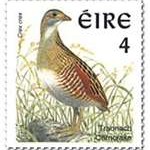There have been two editions of the Atlas of Breeding Birds in Britain and Ireland, one in the early 1970s and another in the early 1990s; now a third will be published next year. Ireland's breeding birds have been subject to detailed annual surveys only since 1998, and not all species are covered, so the new atlas will be very important for the Republic: the clearest indication yet of how its avifauna has fared over the past 40 years. And the preliminary results do not all make happy reading. They show in particular that the birds which might be thought archetypal inhabitants of Ireland's wild west – the waders of the lowland bogs and upland moors such as snipe Gallinago gallinago, lapwing Vanellus vanellus, redshank Tringa totanus and curlew Numenius arquata – are in serious trouble. Since the last atlas, they have declined, respectively, by 11, 32, 40 and 65 per cent. These figures refer to distribution: the percentage of 10km grid squares on the map where the birds are found. The percentage loss of abundance, of the actual numbers of birds, will be very much greater. Indeed, the curlew in Ireland is in such headlong decline that it may soon go extinct. The greatest loss of all in the past 20 years, however, is that of the bird which once symbolised agricultural Ireland more than any other: the corncrake.
There used to be "a corncrake in every acre", with its rasping call on summer evenings; the new atlas will show that Crex crex has disappeared from 78 per cent of grid squares since 1991, and from 93 per cent since 1972. Modernised farming methods are largely to blame, and the bird is now confined to the coastal strip and offshore islands of the far west, such as Tory Island and the two Inishbofins (one each off Donegal and Galway), with the population reduced to fewer than 150 calling males.
Source: Michael McCarthy, The Independent, 1 March 2012
http://www.independent.co.uk/environment/nature/nature_studies/nature-s…

- Login om te reageren
